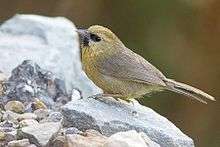Black-chinned babbler
The black-chinned babbler (Cyanoderma pyrrhops) is a babbler species in the family Timaliidae. It occurs in the foothills of the Himalayas from the Murree Hills in Pakistan to eastern Nepal. It inhabits subtropical and temperate forest at 245–2,750 m (804–9,022 ft) altitudes. It is listed as Least Concern on the IUCN Red List.[1]
| Black-chinned babbler | |
|---|---|
 | |
| Adult from Ghatgarh, Nainital district of Uttarakhand. | |
| Scientific classification | |
| Kingdom: | Animalia |
| Phylum: | Chordata |
| Class: | Aves |
| Order: | Passeriformes |
| Family: | Timaliidae |
| Genus: | Cyanoderma |
| Species: | C. pyrrhops |
| Binomial name | |
| Cyanoderma pyrrhops (Blyth, 1844) | |

It is biscuit-coloured, has a black chin and a buffy grey crown. It is 10 cm (3.9 in) long and weighs 8–12 g (0.28–0.42 oz).[2]
Stachyris pyrrhops was the scientific name proposed by Edward Blyth in 1844 who described a greenish olivaceous babbler with a black chin and black lores from Nepal.[3] It was later placed in the genus Stachyridopsis.[4][2]
References
- BirdLife International (2018). "Cyanoderma pyrrhops". The IUCN Red List of Threatened Species. IUCN. 2018: e.T22716190A131972630. doi:10.2305/IUCN.UK.2018-2.RLTS.T22716190A131972630.en.
- Collar, N. J.; Robson, C. (2016). "Black-chinned Babbler (Cyanoderma pyrrhops)". In del Hoyo, J.; Elliott, A.; Sargatal, J.; Christie, D. A.; de Juana, E. (eds.). Handbook of the Birds of the World. 2: Passerines. Barcelona: Lynx Edicions.
- Blyth, E. (1844). "Appendix for Mr. Blyth's report for December Meeting 1842". The Journal of the Asiatic Society of Bengal. 13 (149): 361–395.
- Moyle, R. G.; Andersen, M. J.; Oliveros, C. H.; Steinheimer, F. D.; Reddy, S. (2012). "Phylogeny and Biogeography of the Core Babblers (Aves: Timaliidae)". Systematic Biology. 61 (4): 631–651. doi:10.1093/sysbio/sys027. PMID 22328569.
This article is issued from Wikipedia. The text is licensed under Creative Commons - Attribution - Sharealike. Additional terms may apply for the media files.
